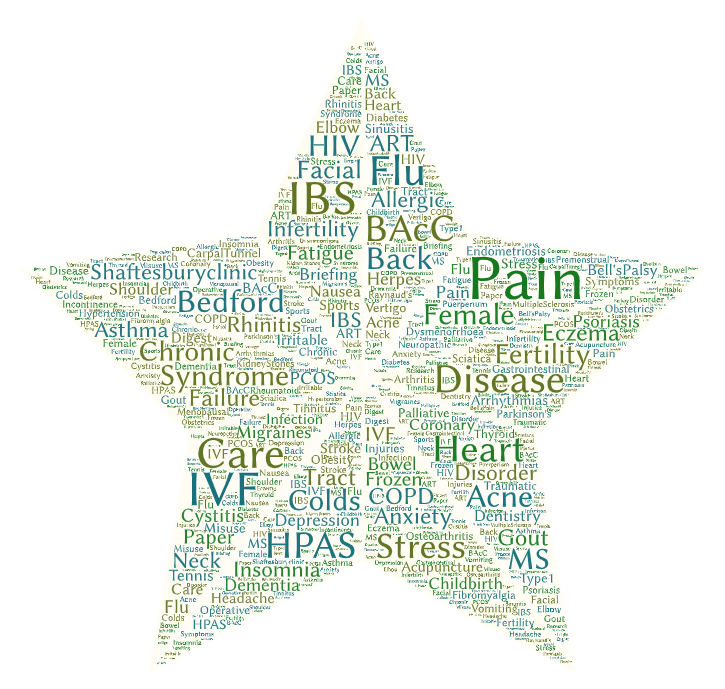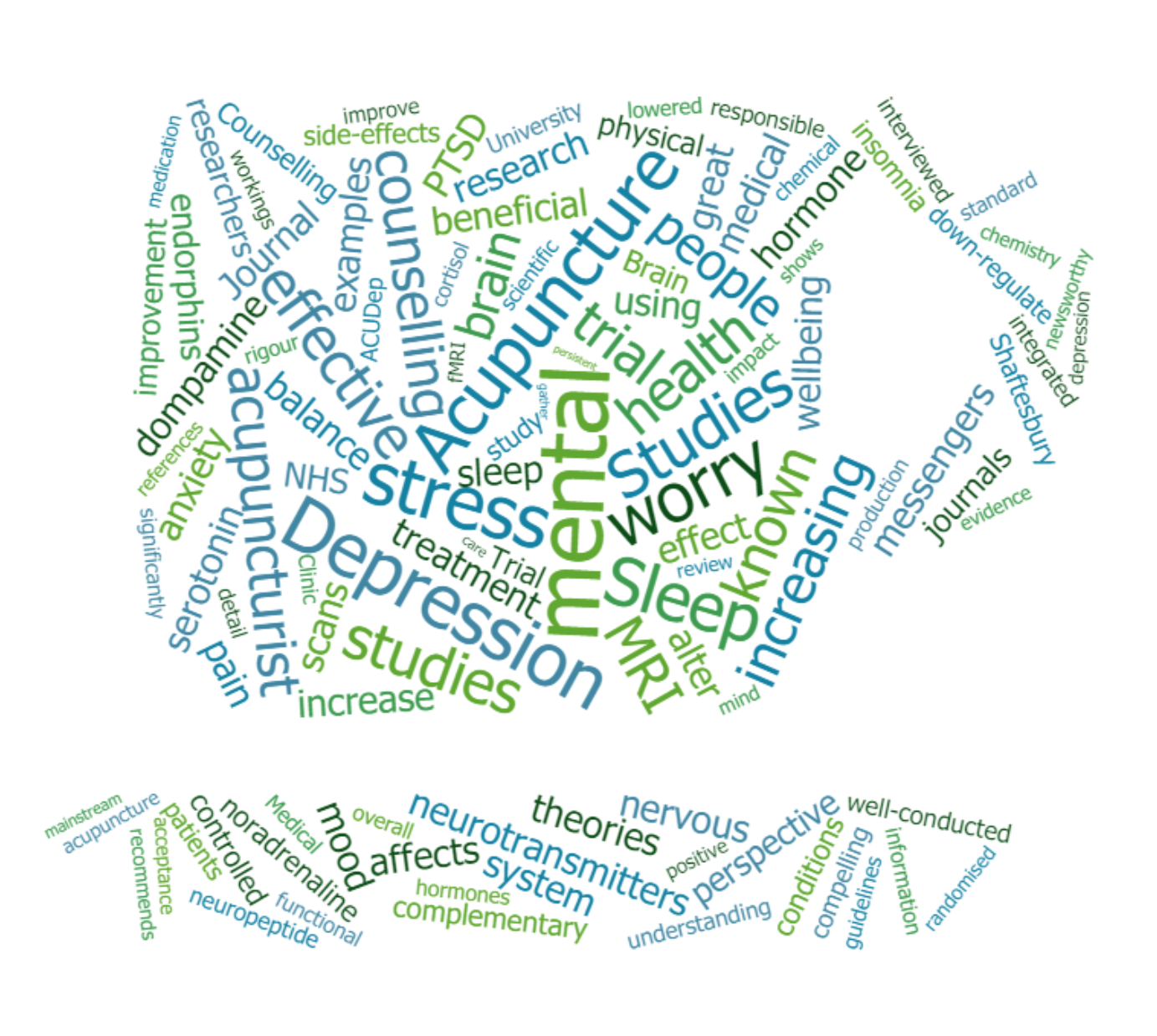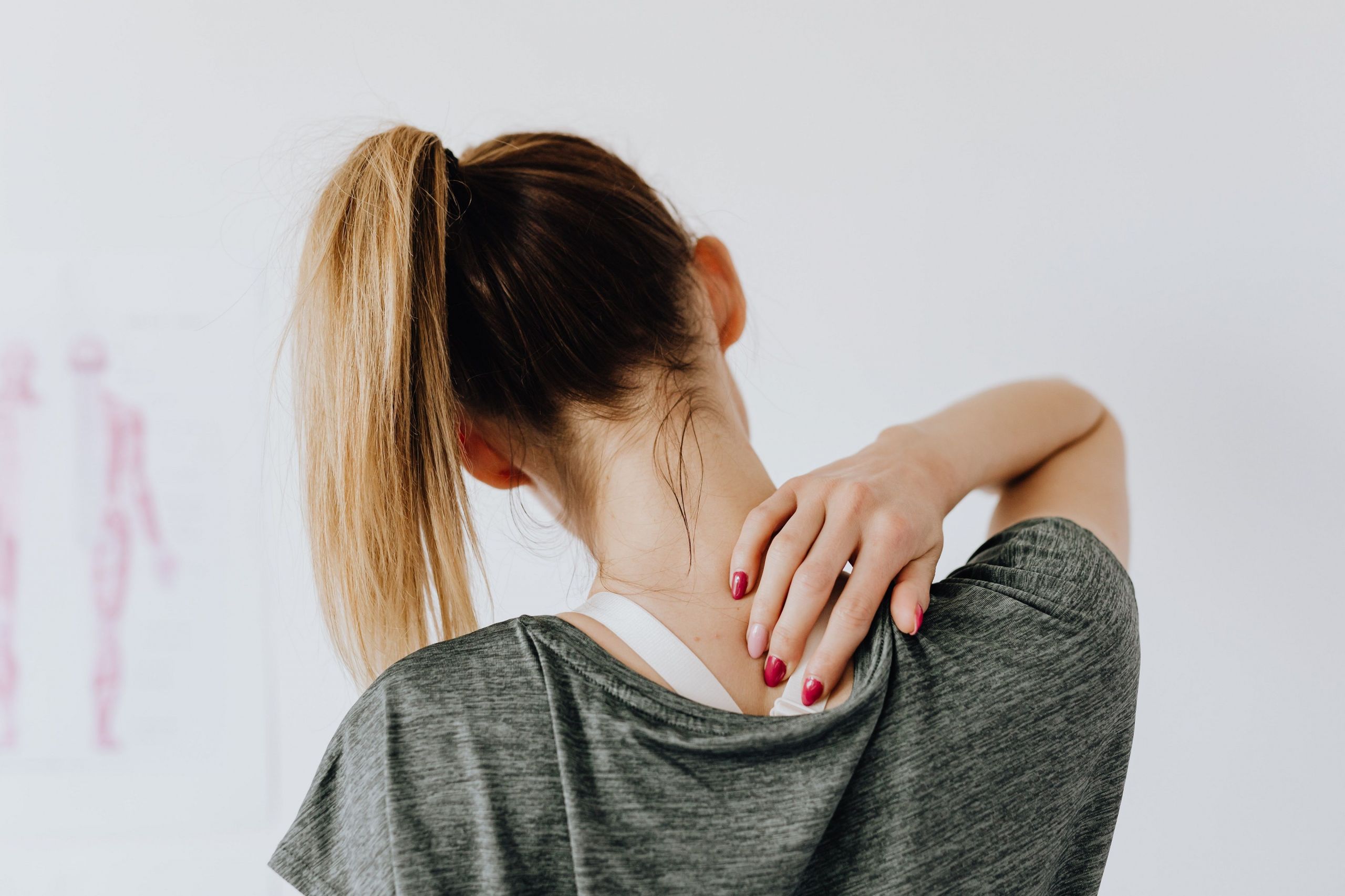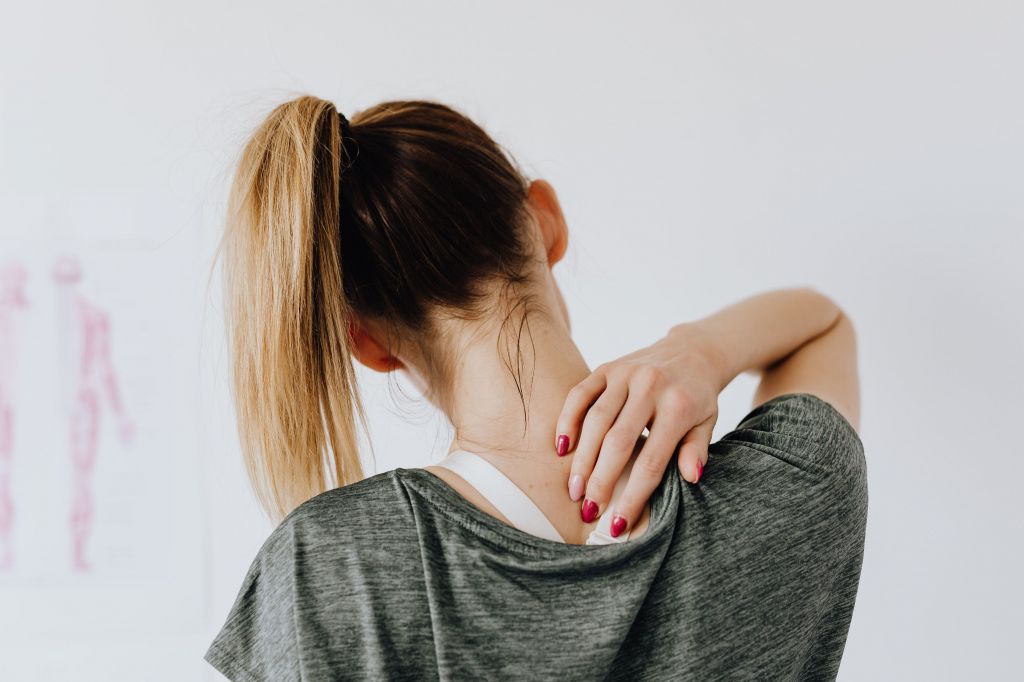Important to know: Chronic health conditions should be addressed under direct medical supervision of your GP or consultant, and acupuncture would be an adjunct or complement to usual care – we advise that you let you doctor know when you use this approach.
Interpreting the research:
When reading health research, it is important to know that Systematic Reviews or Meta Analyses of a large number of high-quality research studies are the very best way to be able to say to what extent a given treatment can address a condition, symptom, or set of symptoms. The next best level of evidence is the individual Randomised Controlled Study (RCT) which uses a systematic technique to compare two or more groups of patients receiving different treatments (or a treatment against a “control”, or no treatment). In acupuncture trials, the nature of the control group is of particular interest as it is hard to blind a patient to whether they are having a needle inserted or not, and even more challenging to blind the researcher/team to this.
The means and quality of how research is carried out varies considerably from country to country, and in terms of how an intervention is compared to another intervention (or a control). Of note is the fact that “sham” acupuncture (where needles are placed in apparently inert locations rather than traditional acupuncture points) is not really an inert process as it has physiological effects, so that comparing sham and “true acupuncture” may therefore not give a clear picture alone; but and form a part of a research body where acupuncture versus no treatment, vs conventional treatment or vs a different approach/modality also form part of the evidence base.
The n= figure (where quoted in research) tells you how many people were participants in the study, and usually the larger a study (when it is of good quality and design), the more likely it is to be reliable and applicable to larger populations. When (statistical) “significance” is discussed in view of studies it has a very particular meaning – it is the confidence in the data (using statistical tests) that tells us how likely a result could have just come about by chance. The lower the possibility of a chance result, the more likely it is due to the intervention in the experiment. When you are reading a trial/study, the “p” is the number telling us of significance, and this must be under 5% (or p less than 0.05) to mean we can say it is a (statistically) “significant” result.
The Research:
A Cochrane review (Zhang et al, 2019) assessed the effectiveness of acupuncture in patients with post-stroke depression [PSD]. 7 RCTs were examined (n=514), from the available 107 initially screened, the rest of which were excluded for various reasons, e.g. the control group using an acupuncture intervention, or more than one intervention in the control group. “Pooled analysis demonstrated that patients in the acupuncture intervention group experienced significantly higher treatment effects than controls” (Zhang, XY et al, 2019); positive trends were seen, although due to the small number of studies, further, high-quality research will be needed to corroborate this in systematic reviews.
A Cochrane systematic review for acupuncture in stroke rehabilitation (Yang et al, 2016), looked at 31 RCTs (n=2257), overall findings were that acupuncture may benefit stroke rehabilitation in terms of dependency, global neurological deficiency, and specific neurological impairments in recovering patients, but with the limitations of the research being small studies and some having quality issues. They called for further, larger RCTs of quality to improve the evidence body. A systematic review and meta analysis (Wu et al, 2010) looked at acupuncture in post stroke rehabilitation, with 38 trials examined, the overall trend was that acupuncture may be effective in assisting in post stroke rehabilitation, with a low side effect profile. The overall quality of most studies was fair, but the authors called for further RCTs to corroborate the trend seen.
A fairly recent systematic review of 12 RCTs (Yang et al, 2018) looked at warm-needle moxibustion for spasticity (limb spasm) after stroke; the researchers stating this showed promise as an approach, but that larger studies would be of benefit to the research base in future.
A recent systematic review and meta-analysis looked at 28 RCTs (n=1747; Zhang, B et al; 2019) and found significantly positive effects upon improving post stroke aphasia (PSA), which is the impact upon communication and language function after a stroke. Sun et al had drawn similar conclusions in their 2012 literature review of 100 articles in this field.
A systematic review of 207 studies of acupuncture for depression of different kinds (Zhang et al, 2010) found 20 RCTs for meta-analysis, and concluded that acupuncture was able to improve post stroke depression, and had a low side-effect risk. A systematic review and meta-analysis of 13 RCTs (n=1046; Chan et al, 2015), found a “significant difference in favor of acupuncture combined with selective serotonin reuptake inhibitors (SSRIs)” [sic].
Schaechter et al, 2007 has looked at the effect as well as brain scan outcomes for upper limb function and motor cortex on fMRI (a type of brain scan that shows activity in real time). They concluded that acupuncture may improve function of the affected upper limb in this patient group, and of interest this coincided with greater change in the ipsilesional motor cortex in the acupuncture group (vs control). A very small study, so the effects themselves should be interpreted with caution, however the fMRI results are an objective measure.
A small pilot study (n=28; Youn et al, 2013) found positive trends for electro-acupuncture on post-stroke depression in patients with different degrees of motor function impairments. Of interest was that the degree of improvement in depression was greater in the group with less impaired mobility, than it was in the severely impaired group. Effect upon motor impairment was not demonstrated in this small study. The strength of the evidence was limited by the lack of a control group, and small sample size, and the researchers stated that further studies are needed to further look at the mechanisms of action for these outcomes.
Another pilot, controlled trial (n=43; Man et al, 2014) used a combination of dense cranial electroacupuncture stimulation and body acupuncture for post-stroke depression, groups compared acupuncture + SSRIs vs sham (non-invasive) acupuncture + SSRIs. Again, positive trends were seen, but the study was small and only single-blinded, necessitating further, larger, double blinded studies.
Another RCT (Li & Chen, 2023) looked at post-stroke thalamic pain, a type of chronic pain caused by damage to the Thalamus, the sensory area of the brain. Coming on straight after a brain injury, or developing months or years later, thalamic pain can impact a person’s quality of life and mental health. From 5 studies (n=368), they found acupuncture effective in reducing thalamic pain after stroke, concluding it was a promising treatment for thalamic pain, and calling for further large-scale and high-quality trials to confirm.
Mechanisms of Action:
Acupuncture has been shown through studies using MRI (brain scans) to have a positive effect on neuroplasticity in several brain areas (through neural growth and connections) after stroke (Zhang et al, 2021 reviewed 25 human, and 5 animal studies).
Acupuncture-induced changes in brain activity have been found in studies: Xie et al (2013, n= 17) looked at healthy vs post stroke patients using fMRI (brain scans), and in particular the connections between the primary sensorimotor cortex and cerebellum, and the effect acupuncture treatment had upon this connection (which is reduced in stroke patients). Increased connectivity was seen in one area (the culmen) in the stroke patients after acupuncture, and in further areas in the healthy controls. This is a promising research area with demonstratable effects. Li et al, 2017 have also looked at biomarkers in fMRI and a promising role for acupuncture.
Another, recent fMRI study (Han et al, 2019) looked at communication between brain cortices with damaged white matter in post stroke patients. As well as finding a particular brain area biomarker for motor deficit in the lower limb in this patient group (which may inform future approaches), they found that acupuncture administration increased communication between the cortices, even in the damaged areas of the brain, which in turn may influence motor improvement. Larger, future studies will shed more light on these mechanisms.
Another fMRI study (Wu et al, 2018) entitled “structural changes induced by acupuncture in the recovering brain after ischemic stroke” used 2 groups of stroke patients (n=21), finding the acupuncture group showed a greater degree of improvement than the control group, and alongside this, greater grey matter changes were seen in the acupuncture group, along with evoked structural reorganisation. A small study, it nonetheless contributes to a growing body of research in the area, and future larger studies will be of great interest.
Per Cai et al, (2018), acupuncture has been shown to have an anti-apoptotic effect in neurologic disorders (apoptosis is the death of cells). Acupuncture may also help to protecting neurons and facilitating recovery in stroke patients, per another small neuroimaging study (Shen et al, 2012; n=20).
Brain remodelling is about how function is rebuilt after a stroke; in their 2014 study “Acupuncture Induces Time-Dependent Remodelling Brain Network on the Stable Somatosensory First-Ever Stroke Patients: Combining Diffusion Tensor and Functional MR Imaging”, Bai et al used MRI to look at what happened in the brains of post stroke patients when acupuncture was administered. The small study has preliminary results to indicate there are physical reasons why acupuncture may form part of the picture in neuroplasticity recovery for these patients, showing how further objective and measurable research can be carried out in an area that shows promise.
More recently, studies and research have turned to measurable biomarkers as targets for looking at the effects of interventions, including acupuncture. We know acupuncture can affect certain biomarkers in the body, including neurotransmitters, as well as having measurable effects on the brain (that can be seen in MRI’s scans, for example). Studies such as Li et al, (2022) have looked at very specific gene expressions as biomarkers that can be targeted and measured for post stroke depression, so that for example in future studies they can be measured for their objective effects, alongside the other measures used that can be less objective (e.g. patient’s assessment of their own symptoms).
Another fMRI study (Wu et al, 2018) entitled “structural changes induced by acupuncture in the recovering brain after ischemic stroke” used 2 groups of stroke patients (n=21), finding the acupuncture group showed a greater degree of improvement than the control group, and alongside this, greater grey matter changes were seen in the acupuncture group, along with evoked structural reorganisation. A small study, it nonetheless contributes to a growing body of research in the area, and future larger studies will be of great interest.
A specific acupuncture point (GB34) was used in an fMRI brain imaging study, and demonstrated increased connectivity in post stroke patients in connectivity in the motor cortices after application of the acupuncture point (Ning et al, 2017). Other neuroimaging studies of stroke patients undergoing acupuncture include Huang et al (2011) regarding upper limb function; Li et al (2006,and n=24); Li et al (2011, n=28) emphasising aphasia.
Further, forthcoming studies will also look at this area, including the expected RCT “efficacy of acupuncture on cognitive function in poststroke depression” as outlined in the Chen at al’s (2022) study protocol for PSD, this will entail a randomized, placebo-controlled (acupuncture vs sham), single-blinded trial (n=56). Their primary outcome measure will be degree of depression on the HAMD-17 scale, the researchers will not only look a depression and cognition outcomes, but also ERP (Event-related potentials) which is a measure of brain activity, made using electrodes on the scalp, and an objective measure of changes that may be elicited from an intervention. We’ll look out for the trial, and update once it’s published.
A study protocol (Zhang et al, 2022) has been put forward very recently for a functional neuroimaging study to look at dyskinesia (uncontrolled, involuntary movement) post stroke: a particular type of acupuncture using points around the eye, to look at the mechanisms of action using an RCT design with n=90, it will be of interest to see the outcome of this larger neuroimaging study.
In animal models, electro-acupuncture was found to alleviate cerebral oedema in rats following induced stroke (Zhang et al, 2011); furthermore, Wu et al, (2012), found differences between two rat groups with induced stroke, whereby acupuncture improved neuronal regeneration, as well as expression of two proteins – neuron growth protein B-50 and synaptophysin (which is involved in nerve impulse generation), both are associated with nerve regeneration.
In an MRI study in rats, electro acupuncture was found to increase brain region activity of the motor cortex, dorsal thalamus, and striatum (Lin et al, 2017). Other MRI animal model studies have suggested that acupuncture may have a protective effect on particular brain areas, including the hippocampus, retrosplenial cortex, cingulate gyrus, prelimbic cortex, and sensory cortex (for example, Wen et al, 2018).
References:
Bai, L., Tao, Y., Wang, D., Wang, J., Sun, C., Hao, N., Chen, S. and Lao, L., 2014. Acupuncture induces time-dependent remodelling brain network on the stable somatosensory first-ever stroke patients: combining diffusion tensor and functional MR imaging. Evidence-Based Complementary and Alternative Medicine, 2014.
Cai, W. and Shen, W.D., 2018. Anti-apoptotic mechanisms of acupuncture in neurological diseases: a review. The American Journal of Chinese Medicine, 46(03), pp.515-535.
Chan, Y.Y., Lo, W.Y., Yang, S.N., Chen, Y.H. and Lin, J.G., 2015. The benefit of combined acupuncture and antidepressant medication for depression: a systematic review and meta-analysis. Journal of Affective Disorders, 176, pp.106-117.
Chen, L., Chen, Y., Wu, L., Fu, W., Wu, L. and Fu, W., 2022. Efficacy of acupuncture on cognitive function in poststroke depression: study protocol for a randomized, placebo-controlled trial. Trials, 23(1), pp.1-9.
Han, X., Bai, L., Sun, C., Niu, X., Ning, Y., Chen, Z., Li, Y., Li, K., Lyu, D., Fu, C. and Cui, F., 2019. Acupuncture enhances communication between cortices with damaged white matters in poststroke motor impairment. Evidence-Based Complementary and Alternative Medicine, 2019.
Huang, Y., Xiao, H., Chen, J., Qu, S., Zheng, Y., Lu, Y. and Lai, X., 2011. Needling at the Waiguan (SJ5) in healthy limbs deactivated functional brain areas in ischemic stroke patients: A functional magnetic resonance imaging study. Neural Regeneration Research, 6(36), pp.2829-2833.
Li, G., Jack Jr, C.R. and Yang, E.S., 2006. An fMRI study of somatosensory‐implicated acupuncture points in stable somatosensory stroke patients. Journal of Magnetic Resonance Imaging: An Official Journal of the International Society for Magnetic Resonance in Medicine, 24(5), pp.1018-1024.
Li, G. and Yang, E.S., 2011. An fMRI study of acupuncture-induced brain activation of aphasia stroke patients. Complementary Therapies in Medicine, 19, pp.S49-S59.
Li, Y., Wang, Y., Liao, C., Huang, W. and Wu, P., 2017. Longitudinal brain functional connectivity changes of the cortical motor-related network in subcortical stroke patients with acupuncture treatment. Neural Plasticity, 2017.
Li, M., Ding, R., Yang, X. and Ran, D., 2022. Study on Biomarkers Related to the Treatment of Post-Stroke Depression and Alternative Medical Treatment Methods. Neuropsychiatric Disease and Treatment, 18, pp.1861-1873.
Li, W. and Chen, S., 2023. Acupuncture for thalamic pain after stroke: A systematic review and meta-analysis. Medicine, 102(9), pp.e33006-e33006.
Liang, S., Lin, Y., Lin, B., Li, J., Liu, W., Chen, L., Zhao, S. and Tao, J., 2017. Resting-state functional magnetic resonance imaging analysis of brain functional activity in rats with ischemic stroke treated by electro-acupuncture. Journal of Stroke and Cerebrovascular Diseases, 26(9), pp.1953-1959.
Man, S.C., Hung, B.H., Ng, R.M., Yu, X.C., Cheung, H., Fung, M.P., Li, L.S., Leung, K.P., Leung, K.P., Tsang, K.W. and Ziea, E., 2014. A pilot controlled trial of a combination of dense cranial electroacupuncture stimulation and body acupuncture for post-stroke depression. BMC complementary and alternative medicine, 14(1), pp.1-8.
Ning, Y., Li, K., Fu, C., Ren, Y., Zhang, Y., Liu, H., Cui, F. and Zou, Y., 2017. Enhanced functional connectivity between the bilateral primary motor cortices after acupuncture at Yanglingquan (GB34) in right-hemispheric subcortical stroke patients: a resting-state fMRI study. Frontiers in Human Neuroscience, 11, p.178.
Schaechter, J.D., Connell, B.D., Stason, W.B., Kaptchuk, T.J., Krebs, D.E., Macklin, E.A., Schnyer, R.N., Stein, J., Scarborough, D.M., Parker, S.W. and McGibbon, C.A., 2007. Correlated change in upper limb function and motor cortex activation after verum and sham acupuncture in patients with chronic stroke. The journal of alternative and complementary medicine, 13(5), pp.527-532.
Shen, Y., Li, M., Wei, R. and Lou, M., 2012. Effect of acupuncture therapy for postponing Wallerian degeneration of cerebral infarction as shown by diffusion tensor imaging. The Journal of Alternative and Complementary Medicine, 18(12), pp.1154-1160.
Sun, Y., Xue, S.A. and Zuo, Z., 2012. Acupuncture therapy on apoplectic aphasia rehabilitation. Journal of traditional Chinese medicine, 32(3), pp.314-321.
Wen, T., Zhang, X., Liang, S., Li, Z., Xing, X., Liu, W. and Tao, J., 2018. Electroacupuncture ameliorates cognitive impairment and spontaneous low-frequency brain activity in rats with ischemic stroke. Journal of Stroke and Cerebrovascular Diseases, 27(10), pp.2596-2605.
Wu, P., Mills, E., Moher, D. and Seely, D., 2010. Acupuncture in poststroke rehabilitation: a systematic review and meta-analysis of randomized trials. Stroke, 41(4), pp.e171-e179.
Wu, Z., Hu, J., Du, F., Zhou, X., Xiang, Q. and Miao, F., 2012. Long-term changes of diffusion tensor imaging and behavioural status after acupuncture treatment in rats with transient focal cerebral ischaemia. Acupuncture in Medicine, 30(4), pp.331-338.
Wu, P., Zhou, Y.M., Liao, C.X., Tang, Y.Z., Li, Y.X., Qiu, L.H., Qin, W., Zeng, F. and Liang, F.R., 2018. Structural changes induced by acupuncture in the recovering brain after ischemic stroke. Evidence-based complementary and alternative medicine: eCAM, 2018.
Xie, Z., Cui, F., Zou, Y. and Bai, L., 2014. Acupuncture enhances effective connectivity between cerebellum and primary sensorimotor cortex in patients with stable recovery stroke. Evidence-Based Complementary and Alternative Medicine, 2014.
Yang, A., Wu, H.M., Tang, J.L., Xu, L., Yang, M. and Liu, G.J., 2016. Acupuncture for stroke rehabilitation. Cochrane Database of Systematic Reviews, (8).
Yang, L., Tan, J.Y., Ma, H., Zhao, H., Lai, J., Chen, J.X. and Suen, L.K., 2018. Warm-needle moxibustion for spasticity after stroke: a systematic review of randomized controlled trials. International journal of nursing studies, 82, pp.129-138.
Youn, J.I., Sung, K.K., Song, B.K., Kim, M. and Lee, S., 2013. Effects of electro-acupuncture therapy on post-stroke depression in patients with different degrees of motor function impairments: a pilot study. Journal of physical therapy science, 25(6), pp.725-728.
Zhang, Z.J., Chen, H.Y., Yip, K.C., Ng, R. and Wong, V.T., 2010. The effectiveness and safety of acupuncture therapy in depressive disorders: systematic review and meta-analysis. Journal of affective disorders, 124(1-2), pp.9-21.
Zhang, F., Wu, Y. and Jia, J., 2011. Electro-acupuncture can alleviate the cerebral oedema of rat after ischemia. Brain Injury, 25(9), pp.895-900.
Zhang, B., Han, Y., Huang, X., Liu, Z., Li, S., Chang, J. and Gao, Y., 2019. Acupuncture is effective in improving functional communication in post-stroke aphasia. Wiener Klinische Wochenschrift, 131(9), pp.221-232.
Zhang, X.Y., Li, Y.X., Liu, D.L., Zhang, B.Y. and Chen, D.M., 2019. The effectiveness of acupuncture therapy in patients with post-stroke depression: an updated meta-analysis of randomized controlled trials. Medicine, 98(22).
Zhang, J., Lu, C., Wu, X., Nie, D. and Yu, H., 2021. Neuroplasticity of acupuncture for stroke: an evidence-based review of MRI. Neural Plasticity, 2021.
Zhang, D., Wang, Y., Li, H., Ma, J., Sun, J., Wu, Z., Zhang, G. and Jin, S., The Central-Peripheral Coupling Effect of Ocular Acupuncture Kinesitherapy in Post-Stroke Dyskinesia: A Functional Neuroimaging and Neurotic Electrophysiology Study Protocol. Frontiers in Neurology, p.1889.
Resources:
The British Acupuncture Council (BAcC) evidence based factsheet about Stroke including specific research, trials and mechanisms of action for acupuncture in this condition.
The British Acupuncture Council Review Paper: Stroke and Acupuncture: The evidence for effectiveness





